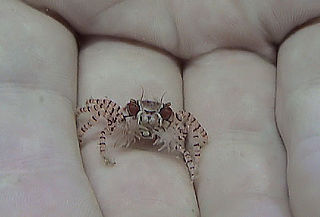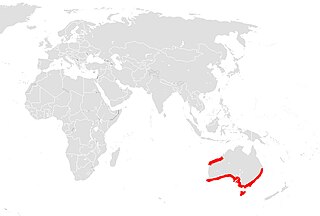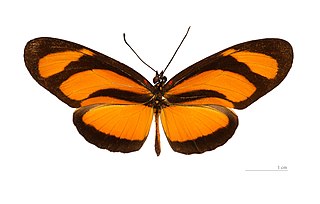
Trypaea australiensis, known as the (marine) yabby or ghost nipper in Australia, or as the one-arm bandit due to their occasional abnormally large arm, and as the Australian ghost shrimp elsewhere, is a common species of mud shrimp in south-eastern Australia, and may be the only extant species in the genus Trypaea. T. australiensis is a popular bait used live or frozen by Australians targeting a range of species. It grows to a length of 6 centimetres (2.4 in) and lives in burrows in mudflats or sandbanks, especially in or near estuaries.
Thompsonia is a genus of barnacles which has evolved into an endoparasite of other crustaceans, including crabs and snapping shrimp. It spreads through the host's body as a network of threads, and produces many egg capsules which emerge through joints in the host's shell.

The Australian ghost shrimp, marine yabby, or ghost nipper is a species of ghost shrimp in the family Callianassidae, found in Australia and the Indo-West Pacific region.

Metanephrops australiensis, commonly known as Australian scampi or the northwest lobster, is a species of lobster. It is found off the north-west coast of Western Australia, ranging from the city of Eucla to Indonesia. It is prolific near Port Hedland.

Flora Australiensis: a description of the plants of the Australian Territory, more commonly referred to as Flora Australiensis, and also known by its standard abbreviation Fl. Austral., is a seven-volume Flora of Australia published between 1863 and 1878 by George Bentham, with the assistance of Ferdinand von Mueller. It was one of the famous Kew series of colonial floras, and the first flora of any large continental area that had ever been finished. In total the flora included descriptions of 8125 species.

Semecarpus australiensis, commonly known as the tar tree, native cashew, marking nut, or cedar plum, is a species of tree in the cashew and mango family Anacardiaceae, native to parts of Melanesia and northern Australia. Contact with the plant can cause serious allergic reactions, a common characteristic of this family.

Lybia is a genus of small crabs in the family Xanthidae. Their common names include boxer crabs, boxing crabs and pom-pom crabs. They are notable for their mutualism with sea anemones, which they hold in their claws for defense. In return, the anemones get carried around, which may enable them to capture more food particles with their tentacles. Boxer crabs use at least three species of anemones, including Bundeopsis spp. and Triactis producta. The bonding with the anemone is not needed for survival, however, and boxer crabs have frequently been known to live without them, sometimes substituting other organisms such as sponges and corals for the sea anemones.
Peristernia australiensis is a species of sea snail, a marine gastropod mollusk in the family Fasciolariidae, the spindle snails, the tulip snails and their allies.

Lybia edmondsoni is a species of small crab in the family Xanthidae and is endemic to the Hawaiian Islands. Like other members of the genus Lybia, it is commonly known as the pom-pom crab or boxer crab because of its habit of carrying a sea anemone around in each of its claws, these resembling pom-poms or boxing gloves. Its Hawaiian name is kūmimi pua, meaning "inedible flower crab". In ancient times, this animal was used by men claiming to be sorcerers.

Polydectus cupulifer is a species of crab in the family Xanthidae, and the only species in the genus Polydectus. Together with the genus Lybia, it forms the subfamily Polydectinae. It is found in the Indo-Pacific, ranging from Madagascar and the Red Sea in the west to Japan, Hawaii and French Polynesia in the east. P. cupulifer is densely covered with setae (bristles), and frequently carries a sea anemone in each chela (claw).

Triactis is a genus of sea anemone in the family Aliciidae. It is monotypic, having only one species – Triactis producta. This species is found in shallow waters in the Indo-Pacific where it lives on the seabed, rocks and corals. It derives much of its energy needs from the symbiotic algae it contains. It also forms a mutualistic relationship with small Lybia crabs.

Lybia tessellata is a species of small crab in the family Xanthidae. It is found in shallow parts of the tropical Indo-Pacific Ocean. They are found from the east coast of Africa in the Red Sea across Northern Japan and Northern and Eastern Hawaii. Like other members of the genus Lybia, it is commonly known as the pom-pom crab,cheerleader crab, or boxer crab because of its habit of carrying a sea anemone around in each of its claws, these resembling pom-poms or boxing gloves.

Ligia australiensis, the Australian marine slater, is a woodlouse in the family Ligiidae.
Gononemertes australiensis is a parasitic ribbon worm. It lives commensally in the ascidian Pyura pachydermatina found in the sublittoral waters of the New Zealand. G. australiensis was found in specimens of P. pachydermatina collected in Sydney harbor. These worms were found specifically in the atrium of P. pachydermatina. It is dioecious and has several gonads. Each of its gonads produce several oocytes while the male worms carry testes along its parenchyma. Fertilization is external.

Sabellastarte is a genus of marine polychaete worms in the family Sabellidae.

Eueides lybia, the lybia longwing, is a butterfly of the family Nymphalidae. It was described by Johan Christian Fabricius in 1775. It is found from Central America to northern South America, from Nicaragua to Bolivia.

Balanoglossus australiensis is a species of 20 centimetres (7.9 in) long acorn worm in Ptychoderidae family which can be found in Gulf of Carpentaria, New Zealand, Australian cities such as Hawkesbury and Manning as well as Solomon Archipelago and its sea. Their habitat consists of 8–10 inches (200–250 mm) deep sandy burrows where they feed on Ubius species.
Cephalodiscus australiensis is a sessile hemichordate belonging to the order Cephalodiscida.
Branchiostegus australiensis, the Australian tilefish, is a species of marine ray-finned fish, a tilefish belonging to the family Malacanthidae. It is found in the Indo-West Pacific, from off of Sumatra, Indonesia to Shark Bay, in Western Australia. This species reaches a length of 26.6 cm (10.5 in).

Hemisquilla australiensis is a species of mantis shrimp native to Australia and also found in New Zealand.











